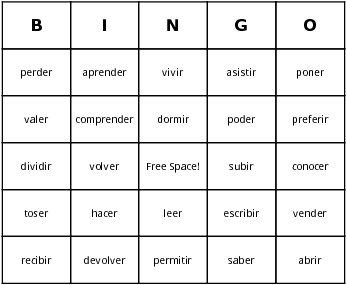
When we form a question that elicits information, the position of the subject pronoun (ellos), if used, frequently follows the conjugated verb. It’s best to memorize these verbs and their corresponding prepositions in this case “asistir a” = “to attend” (school, class).ĭid you remember that when two verbs appear together and there is no change in subject the first verb is conjugated (debo) but not the second (estudiar)? #3 from above: ¿Tú asistes a la universidad?ĭid you put the “a” after the verb “asistes”? Certain verbs take a corresponding preposition after them, and sometimes they don’t translate to anything specific in English. Some vocabulary you might need: poemas=poems universidad=college más tarde=later If you want over 400,000 Spanish verb conjugations with you where ever you go. Now you try out some sentences: use the verbs from the -er and -ir lists above to translate the sentences below. You will find charts to master Spanish verbs ending in IR, ER, AR and more. They are included in the examples below for clarity. OJO ( note): Remember, it is not necessary to use the subject pronouns (ella, Ud., etc.) if it is clear who we are speaking about from the context. Notice only the “nosotros” and “vosotros” forms differ between -er and -ir verbs: (to ask a question: Spanish doesn’t have an equivalent for the auxiliaries “do / does”) For example, “tú comes” has three equivalents in English (the subject pronoun tú isn’t required): Tú comes con ella todos los días. Notice the possibilities of present tense conjugations in Spanish. Let’s take a look at the regular -er ending of the verb comer (to eat): Regular -er ending verbs: The idea of “taking off the verb ending” and then adding other endings to give the verb a subject (yo, tú, ella, etc.) is the same as we did for -ar ending verbs. The conjugation pattern for -er and -ir ending verbs is nearly the same, differing only in the nosotros and vosotros forms.

As mentioned previously, there are three types of verbs in Spanish: those ending in -ar, -er and -ir.


 0 kommentar(er)
0 kommentar(er)
